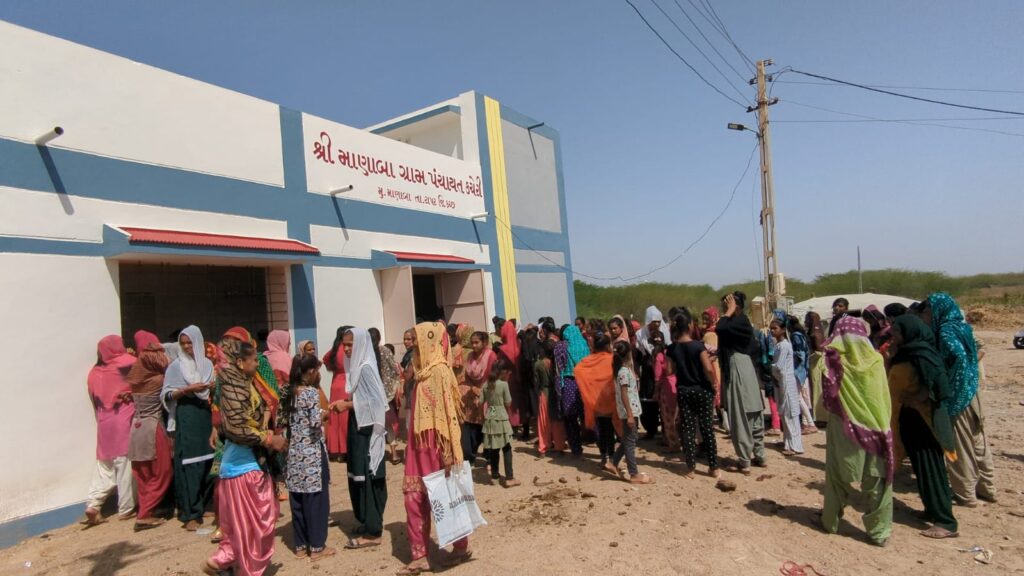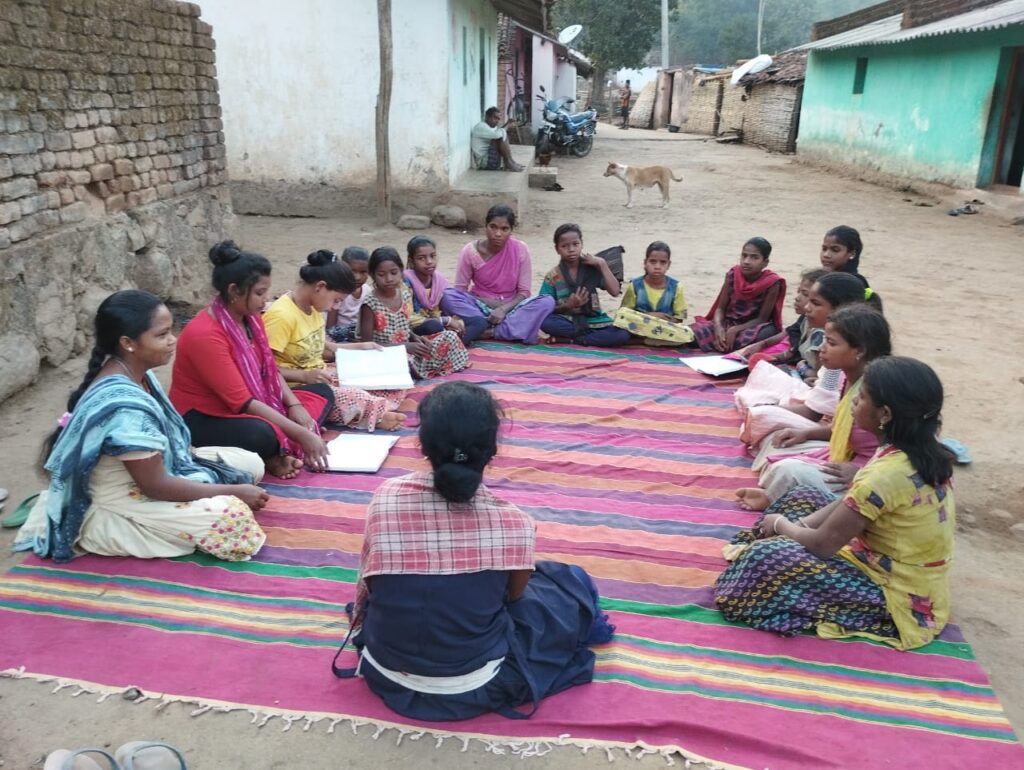This blog is jointly written by Udhisha working with SETU Abhiyan and Adithya working with Swasthya Swaraj
On March 8, the world celebrated International Women’s Day. This year, the focus was on the themes “Inspire Inclusion” and Invest in Women: Accelerate Progress. What this means is that gender equality remains a huge challenge that we need to overcome. Empowering adolescent girls is essential to addressing this challenge.
After enduring colonial rule, the nation eagerly awaited freedom and development for its citizens. The Constitution has given us an inclusive framework to achieve this. The 73rd Amendment Bill that has empowered rural India. The adoption of the Gram Panchayat Development Plan (GPDP) can bring transformative change in rural India. It can also advance gender equality, aligning with the Sustainable Development Goals. At our hosts Swasthya Swaraj and SETU Abhiyan, our focus is on empowering girls. We combine innovative interventions with government programs. Our approach considers regional and community-specific factors. This synergy leads to effective results.
SETU and the Balika Panchayat Initiative for Adolescent Girls
The Women and Child Development Welfare Department of the Gujarat Government started Balika Panchayat in June 2022 in Kutch district. This was a part of the ‘Beti Bachao Beti Padhao’ campaign. The first Balika Panchayat formed was in Kunariya Gram Panchayat. As an NGO based in Bhuj, Kutch, SETU Abhiyan was able to identify two major factors that could make the initiative achieve its objectives: The first was to prepare the girls for active participation through awareness and subject knowledge. And the second was to sensitize the local government to the needs and aspirations of adolescent girls.
The focus was on equipping girls with their decision-making capabilities so that they could be part of the GPDP planning process. They also encouraged gender budgeting (as advocated by the UN) to allocate funds for the adolescent girls and women of their village.
The SETU team visits the villages to encourage adolescent girls to form groups where the team trains them in various topics like constitutional rights, government structure, government schemes, the importance of education, and the importance of having goals. We also hold awareness sessions on gender discrimination, safety, menstrual hygiene, and nutrition in schools and villages.
The focus remains on encouraging adolescent girl groups to form Balika Panchayat who can interact and understand the workings of Gram Panchayat. This enables them to know about the election process of choosing the Sarpanch and members of the Balika Panchayat. The election process instils in them a sense of responsibility to establish and uphold the workings of the body.

Balika Panchayat Election Scene
Impact of the Intervention
- There is an increase in general awareness and confidence
- Girls have started raising questions about gender discrimination and want to discuss the topic and their personal experiences
- They feel responsible for the other girls in their village
- There are suggestions that boys also need to be sensitized to gender equality. “The girls in our village are well aware and attend the meetings and programs regularly. It is the boys who are slightly behind now.” – Balika Panchayat Sarpanch, from Kunariya
- They are responding to harassment girls face, which in rural India is mostly domestic
- The Balika Panchayat has intervened to postpone early marriages, allowing for the pursuit of education, marking a significant milestone
Swasthya Swaraj Intervention in Kalahandi for Adolescent Girls
The Toki Upliftment and Livelihood Self-initiative (TULSI), by Swasthya Swaraj aims to empower tribal adolescent girls. It also seeks to improve their health and nutrition. This is crucial for the survival of mothers and newborns. Many of these young mothers are teenagers or in their early 20s. We empower adolescent girls through community-based training in villages, hamlets, and educational institutions. Tailored training modules address their needs. Topics include sexual and reproductive health, gender equality, common health issues and nutrition. Non-formal education and livelihood skills are part of the training as well. For this purpose TULSI clubs have been formed in 79 project villages and hamlets.
Also read: Encouraging The Next Generation Of Girls and Women of Vadasar, Bhuj
Outcome of the Intervention
- The girls are voicing out against early marriages
- Their confidence and communication skills have increased
- Increased knowledge on nutrition and hygiene

TULSI, Non-formal education initiative in Kalahandi region of Odisha by Swasthya Swaraj
Why is There a Focus on Health in Swasthya Swaraj’s Program?
Kalahandi is a place that is high in illiteracy, and school drop-outs. With all these comes the problem of awareness about child marriage, and early pregnancy. These aren’t the only problems. There are other problems like malaria, tuberculosis, and malnourishment. There is a need to address primary concerns first, provide basic education to the tribal adolescent girls and provide a means of sustenance through livelihood programs.
If you happen to go to a village here and ask a girl, who is studying in the 8th grade, or the 10th grade if she is planning to continue her studies, she might say, “No I’m planning on staying home and helping mom. I don’t want to study.”
While girls do have a primary or secondary education, they somehow hold back due to the societal norms and conditioning that they are used to. It has been proved many times that collectivization is a catalyst for change, as it creates conversations, inspires change and ideas, and allows a bottoms-up system to be implemented that allows initiatives for the girls, by the girls.
“He who has health has hope; and he who has hope has everything.” The proverb explains the state of the tribal areas in Kalahandi. Primarily, the aim is empowerment, but the first step towards it would be addressing the health problems alongside focussing on the other aspects.
Why is There a Focus on Local Governance in Kutch?
Kutch is a region prone to natural disasters and after the 2001 earthquake in Kutch, numerous organizations emerged to aid in local rehabilitation efforts. SETU recognized the significance of involving people in the construction of their homes during the rehabilitation process, both in urban and rural areas. This approach was true even when aid was provided by the government. The facilitation process started from this and expanded to other interventions in the framework of local governance, with the fundamental principle of people’s participation in the decision-making process.
In Kalahandi, more sessions can be conducted to empower adolescent girls. Thus, helping them understand their thoughts and feelings, including their perspectives on the program, their aspirations, and their visions for the future. This will give insights into modifying the program to serve their needs in a more targeted and meaningful manner. A more systematic approach should be adopted and there should be more exposure to the system thereby increasing the efficiency.
Boys too must be part of the sensitizing programs as many of the young husbands are boys who are ignorant of pregnancy and child care and without increasing the awareness among them, the effectiveness and the impact would be lower. Awareness and empowerment should not be the NGO’s sole responsibility. The government should also focus on schemes that will train the girls in their respective villages or the panchayat. By creating awareness and improving accessibility to these programs the participation will also increase.
Following the model used in Kutch will enable the women in Kalahandi to get directly involved in the panchayat and thus become a local leader.
A New Model
Kutch, the largest district in the nation, can adopt a model with more resources and trained volunteers to reach out to the girls. This will help in having a wider coverage starting from collectivizing the girls and giving them the knowledge they need. Panchayat facilitators can develop a system, additionally, villages with active Sarpanches have overall development and foster initiatives for empowering young women. We need to replicate the model village which keeps getting all the attention and resources. It is important to spread the initiative to other villages as well. Resistance to change is inevitable, as the girls and their families have been living in the same traditional pattern for generations
Can an ADKAR (Awareness, Desire, Knowledge, Ability, and Reinforcement) model help? Yes, it can. Most of the staff are experts and have years of experience and knowledge in the field. The question is how can we better channel this for evaluation, reinforcement, and necessary change? Mostly, the interventions and initiatives need to have an impact and fulfil the objective of changing the lives of rural girls




0 Comments